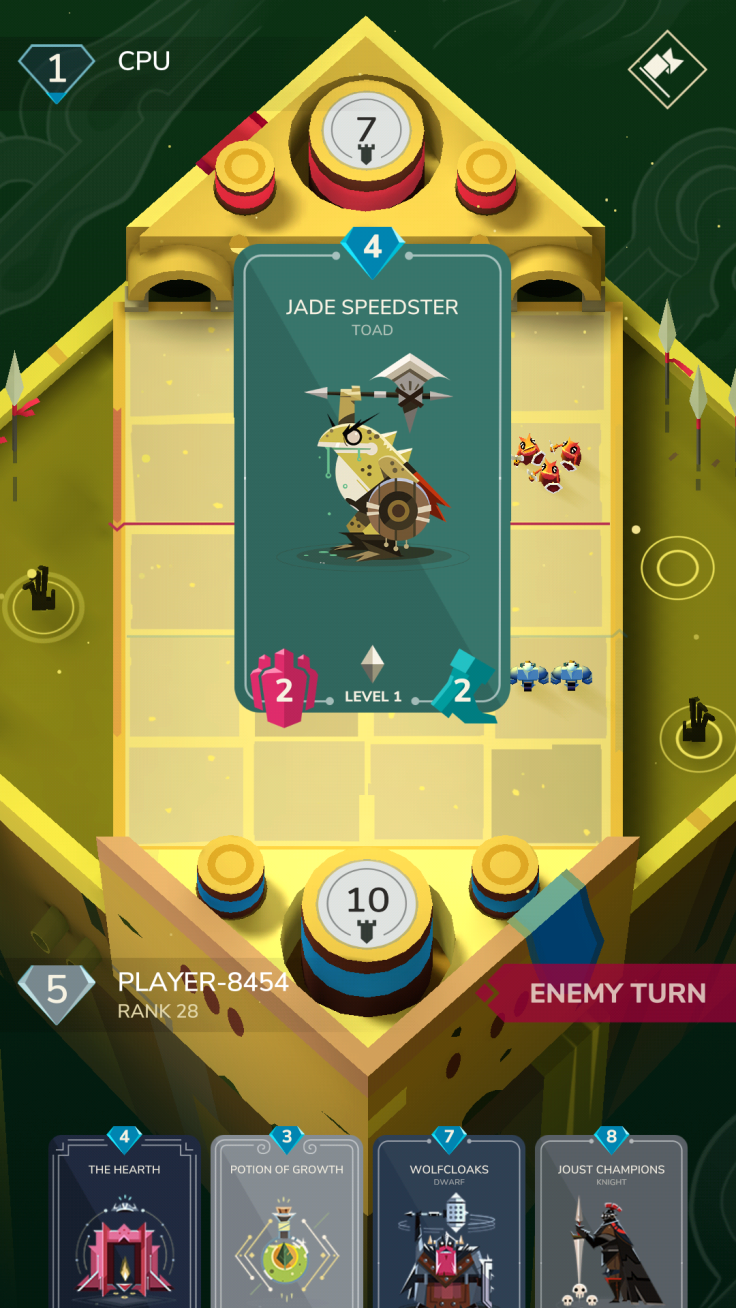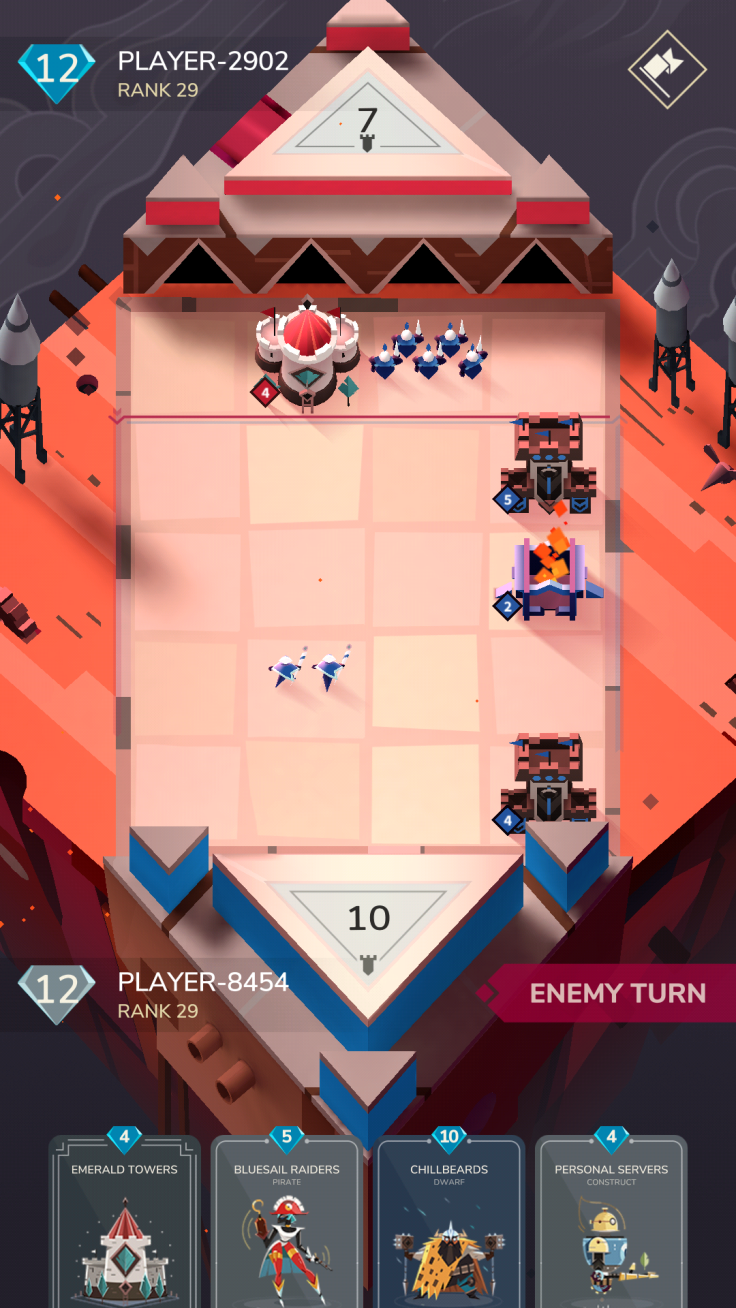Stormbound combines CCG deck building with tile-based tactical movement — think Hearthstone crossed with checkers. The combination of card-based combat and lines of scrimmage creates compelling and cohesive head-to-head battles that reward players who adopt the game’s tactical strategies. However, Stormbound’s unique game mechanics butt up against a precipitous paywall problem. Unless you’re willing to drop hundreds of dollars in a pay-to-win strategy, Stormbound is likely to be limited experience.
Each turn in a Stormbound battle increases a player’s mana pool by one, which enables more or better cards to be tapped and applied to the game board. Since mana doesn’t carry over from turn to turn, players are encouraged to spend everything they can, making each turn more about the best attack strategy than about finicky resource management over the full course of the battle. Simplifying mana management is just one of the many ways Stormbound slims down individual game components. Instead, the game adds tactical complexity through the interplay of the cards in the player’s hand and the spacing of those units, bases and powers on the game board.

One fascinating component of Stormbound not often found in deck building games is the importance of the front lines. Since your objective is to break through the enemy forces and get your fighters into the enemy base, there’s a major emphasis on spawning new units on their side of the board, while killing all the enemy units on your side. Wipe out all the enemies in the nearest row and your opponent will begin their next turn having to place their troops further back.
Actual combat units come in four different factional flavors: Winter Pact, Swarm of the East, Ironclad Union and Tribes of Shadowfen, with different emphasis on big units, swarms and more advanced strategies that involve multiple cards in concert or card abilities. Though attack/defense works on a simple vector with a unit number determining attack strength — lose a fighter, lose one attack — complexity mounts quickly thanks to abilities like Chaotic Pupil’s, “On death, deal 2 damage spread randomly among all surrounding enemies.”
There are also, of course, buff or ability cards, like “Herald’s Hymn,” which adds strength to all the units in a row and advances them forward an extra square. But the really interesting cards are Buildings, which can act like units in a tower defense game, firing buffs or attacks at the beginning of a turn. More importantly, these units help you hold that front line. Advance just one troop far up the board and you can plop a base down that your opponent must first destroy if they ever hope to knock you back.

There are a few downsides to the combinatorial complexity of the Stormbound play system, notably the length of a typical Stormbound battle. While the gradual mana increase makes for a satisfying escalation, from small unit tactics to pixel-splashing swarms and hero units, the pace is way too gradual for bite-sized mobile gaming. Heated battles will often stretch to over 20 minutes.
But far worse than lengthy combat rounds is the game’s freemium strategy. Players without deep pockets can play the handful of “Campaign” rounds against the four factions to win enough cards for a solid starter deck. Daily quests reward “books” that contain multiple randomized cards or gold coins to buy new ones or to upgrade existing cards. But despite the free cards and coins, it quickly becomes evident that non-monetary routes are inadequate if a player has any interest in advancing through the multiplayer battle ranks.
New rank rewards like rubies and coins enables players to purchase upgrades and to earn new cards. It gives off the illusion of fighting your way forward, but a quick look at costs will disabuse anyone of that notion. Getting to Rank 25 nets you 5 rubies, but a “Glorious Book” with ten semi-random cards costs 25 rubies. What’s more, every third hard-won rank rewards just 50 coins (each battle victory wins you 5) — good luck purchasing the 80 to 500 coin card of the day, let alone that plus the 50 or 80 coins (plus exchanging multiple duplicates, like Clash Royale) it costs to upgrade an existing card already in your deck. Butting up against more powerful, paying opponents on higher ranks will slow your progress through rank reward tiers, making it even harder to build a competitive deck, even with a punishing grind.
Of course, dedicated Stormbound fans are welcome to buy “all 36 common, 27 rare & 20 epic cards, including 1 legendary” for $99.99 (faction specific seven-card packs, with one guaranteed epic card, cost $19.99 each). Stormbound is far from the only punishingly expensive freemium game out there, but it is almost completely prohibitive to players unwilling to spend some money.
And it’s not really worth it. Stormbound has a fun combat system that really made for a worthwhile weekend, but the clean aesthetic is really more functional than desire-inspiring. Unlike Magic: The Gathering, you’ll never treasure a Stormbound card as an art object. And while Stormbound could be the next Hearthstone, justifying a little money in exchange for hundreds of hours of play, it doesn’t seem very likely. In its current state, Stormbound is a freemium experience worth it to the exact extent that it’s free.
- Fun tactical gameplay
- In-depth combat
- Punishing leveling
- Expensive pay-to-play attributes








![Best Gaming Mouse For Gamers With Smaller Hands [2025]](https://d.player.one/en/full/227430/best-gaming-mouse-gamers-smaller-hands-2025.png?w=380&h=275&f=fdcf47c1c5fc58d1e41d3be505c12568)










